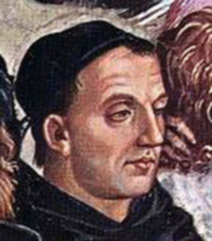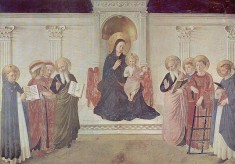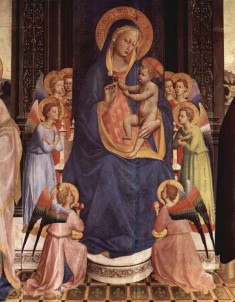| Fra Angelico | |
|---|---|
 |
|
| Born | Guido di Pietro c.1395 Republic of Florence |
| Died | Feb. 18, 1455 (about age 60) Rome, Papal States |
| Nationality | Florentine |
| Movement | Early Renaissance |
| Field | Painting, Frescoes |
| Works | |
As with many artists, the legacy of Fra Angelico was created in his artwork. Yet unlike some other artists, his legacy embodies a spiritual aspect that has led others to believe it was inspired or touched by the angels.
Angelico’s Early Years
The exact date of birth for Fra Angelico is unknown. Many scholars mention c.1400, while others give 1390 or 1387 as the year of his birth. What is known, however, is that he was born in Italy, in Vicchio, Tuscany, in the area known as “Mugello.” This is a valley that follows Northern Florence to the Tuscan-Emilian Apennines, where the Lorraine and Medici families enriched the land with castles and villas. It is also near Fiesole, the place of the Dominican convent he entered after becoming members of the Order of Preachers around 1407.
Influences and Early Work
Before they even entered the Dominican Order, Fra and his brother were known for their artistry. Fra’s artwork was in high demand by patrons of the arts at that time and some believed that he could have earned a living as an artist in the secular world. Fra Angelico received some of his training from Lorenzo Monaco, who was known for illuminating manuscripts, or adding decorative letters and symbols to them to make them more attractive.
Some scholars and analysts say that the handiwork of Fra Angelico can be seen in some of his works during the time of his apprenticeship with Monaco. It is not known exactly when his career as an independent artist actually began, but there is known documentation regarding payment received for work done in 1418.
Fra Angelico’s training was as an “illuminator.” An Illuminator added decorations to manuscripts, such as the Bible. Missals and other religious works were also illustrated by him. In the early 1420s, he and his brother operated a workshop for painters and those who copied documents.
 Later, he began painting frescoes and doing altarpieces for the church. These were done for the monastery of San Domenico of Fiesole, and later, for the monastery of San Marco in Florence, Italy. It was here that his most famous works were painted, although some early ones done in Fiesole are well-known today. These include The Coronation of the Virgin and the Altarpiece of the Annunciation.
Later, he began painting frescoes and doing altarpieces for the church. These were done for the monastery of San Domenico of Fiesole, and later, for the monastery of San Marco in Florence, Italy. It was here that his most famous works were painted, although some early ones done in Fiesole are well-known today. These include The Coronation of the Virgin and the Altarpiece of the Annunciation.
Angelico’s Later Years
Florence, Italy, where Angelico decorated the new convent of San Marco, is where some of his most important work was done. Dormitory cells were painted to allow the friars to focus on prayer and Christ. In 1445, Fra Angelico was invited to Rome by the Pope. He painted the frescoes of two chapels with scenes of St. Lawrence and St. Stephen. He returned to his old convent in Fiesole in his last years, but died in Rome in 1455.
After his death, he became known as Fra Angelico, a way of celebrating his status as an angelic painter. In Italian, he was known as “il Beato Angelico,” or the “Beato,” in reference to the blessed nature of his works and his religious life.
His full moniker today is Blessed Fra Angelico Giovanni da Fiesole. When he entered the Dominican order he chose the name “Fra Giovanni da Fiesole” for himself, and that is how his contemporaries knew him.
Angelico’s Influences and Style
 Early renaissance style permeated throughout Angelico’s work as did International Gothic style, such as in his Adoration of the Magi piece. His religion was another strong influence. He believed that in order to depict Christ in a painting, one had to be as “Christ-like” as possible. Some of his works that focused on Christ include Deposition of Christ and Last Judgment. Before he started any spiritual work, he always prayed for spiritual guidance throughout each stroke of the brush.
Early renaissance style permeated throughout Angelico’s work as did International Gothic style, such as in his Adoration of the Magi piece. His religion was another strong influence. He believed that in order to depict Christ in a painting, one had to be as “Christ-like” as possible. Some of his works that focused on Christ include Deposition of Christ and Last Judgment. Before he started any spiritual work, he always prayed for spiritual guidance throughout each stroke of the brush.
Angelico was very skilled in his creation of figures as he was able to convey emotion and depth beautifully. A psychologically, spiritual penetration can be seen through his portrayal of the saints and other religious figures. Although religious in nature, his paintings also contained a sense of realism and perspective from a secular sense, too.